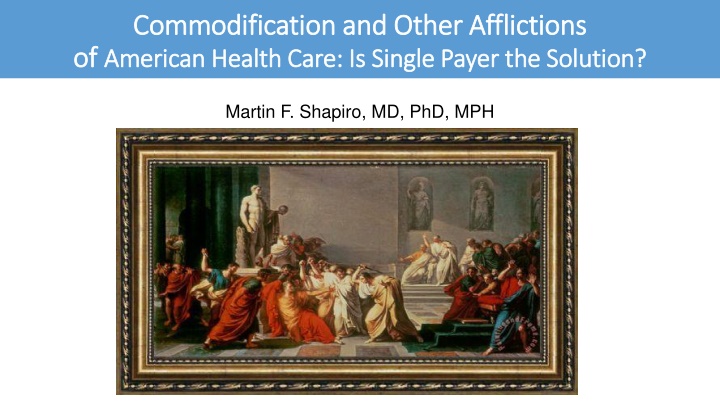
American Health Care: Single Payer Solution, Trends, and Impediments
Explore the challenges and potential solutions in American health care, including the benefits of a single-payer system, rising health spending, life expectancy trends, and obstacles to policy reform due to various stakeholder interests.
Download Presentation

Please find below an Image/Link to download the presentation.
The content on the website is provided AS IS for your information and personal use only. It may not be sold, licensed, or shared on other websites without obtaining consent from the author. If you encounter any issues during the download, it is possible that the publisher has removed the file from their server.
You are allowed to download the files provided on this website for personal or commercial use, subject to the condition that they are used lawfully. All files are the property of their respective owners.
The content on the website is provided AS IS for your information and personal use only. It may not be sold, licensed, or shared on other websites without obtaining consent from the author.
E N D
Presentation Transcript
Commodification and Other Afflictions Commodification and Other Afflictions of of American Health Care: Is Single Payer the Solution? American Health Care: Is Single Payer the Solution? Martin F. Shapiro, MD, PhD, MPH
Conflicts of interest Conflicts of interest No financial conflicts of interest with ineligible companies
Health spending in the United States sits well above Health spending in the United States sits well above all other OECD countries all other OECD countries Source: OECD Health Statistics 2021
Trends in life expectancy 1980 Trends in life expectancy 1980- -2021 in the U.S. vs. comparable countries vs. comparable countries 2021 in the U.S.
Why havent we been able to pull the policy levers that can solve these problems? The ways in which the groups of actors conceptualize health and health care, pursue their interests and perceived needs, and interact accordingly create impediments to a system that is rational, just, and efficient
Who stands in the way of an equitable, efficient, and Who stands in the way of an equitable, efficient, and effective health care system? effective health care system? Physicians Medical schools Corporations Hospitals/health systems Dialysis, nursing homes, pharmacy chains Manufacturers (medicines, machines, EMRs) Insurers Investors Scientists Government Employers and employee groups Patients, families, and many community organizations
Three phenomena shape the circumstances and Three phenomena shape the circumstances and experience of health care in contemporary society experience of health care in contemporary society The treatment of health care and health as commodities by actors within and without the system The consciousness of actors attitudes, values, perceived needs, expectations, interests, and capacities which shape attitudes and behavior in relation to health care The communication and relationships among these actors which reinforce existing arrangements
Health Systems and Medical Groups Sales Maximize market share of covered lives Maximize reimbursement Minimize risk (poor people with Medicaid or no insurance) Contract with healthy populations Promote lucrative product lines and procedures Seek 9-figure surpluses Pay executives 7 to 8-figure salaries (>30% financial performance-based bonuses)
Other Corporate Interests Health Insurance Companies Producers of Goods Nursing Home, Dialysis and Pharmacy Chains Machines, Devices, EMRs Pharmaceuticals, Biologics Single payer is an existential threat Oppose expanding public coverage Privatize lucrative parts of public programs Maximize revenue through denials, copays, deductibles Maintain revenue streams Care without limits Induce sales by publicizing which hospitals have the latest gadgets Oppose taxation Prohibitive product pricing (EMR) Induce demand Ads to consumers and providers Maximize price points Deter competition Evergreening Oppose price negotiation and importation Investors Maximize income from procedures Minimize services Take quick profits
Clinicians and Specialty Societies Economic interests Block revisions in relative payment for procedures vs. cognitive services by dominating the RVU Update Committee (RUC) Society guidelines do not threaten revenue flow Minimize risk, optimize casemix & insurance type Run the till as long as you can Lub-dub
How much do doctors make by specialty? How much do doctors make by specialty? Source: Weatherby Healthcare
Clinicians and Specialty Societies Attitudes, aptitudes, values Not selected for comfort in providing cognitive services Poor communication skills Handle uncertainty poorly Not well-trained to limit care Avoid long-term relationships with patients Prefer narrow tasks Patients bear the consequences Economic interests Successfully resist revisions in relative payment for procedural vs. cognitive services by dominating the RVU Update Committee (RUC) Society guidelines do not threaten revenue flow Minimize risk, optimize casemix & insurance type Run the till as long as you can Lub-dub
The Medical Student For A Few Dollars More ?
The good physician treats the disease; the great physician treats the patient with the disease. ---William Osler
Can we change clinicians priorities and competencies? Pay doctors for time, not piecework. Specialty pay should differ only modestly to account for time in training Incentivize clinicians to seek psychotherapy to help them better relate to their patients needs and values All physicians should have periodic training on communication and negotiation with patients ethics, morals, and social responsibilities Mandate that proceduralists and administrators meet regularly to set targets to reduce use of low value care
Universities and medical schools: part of the problem Undergraduate medical education Admission criteria emphasize grades and test scores, not values and empathy Admitted students, 69% biological & physical science majors, 4% humanities Income : 13% in lowest 40%; 51% in top 20%; 28% in top 5% 13.4% Black or Hispanic (vs. 32% of U.S. population) Curriculum is biologically reductionist; social sciences and humanities are an afterthought White coat ceremonies as triumphalism Negative socialization: loss of idealism as students advance Students focus on specialty income from day one
Universities and medical schools: part of the problem Postgraduate medical education Little modeling of cost constraint Little exposure to humanities and social sciences Little opportunity to address discomfort in the clinician-patient relationship Little emphasis on effective communication Ambulatory experiences are generally awful Little attention paid to effective communication
Universities and medical schools: part of the problem Academic practice Academic practices often segregated by insurance type Business plan is almost always to use clinical revenue to support other programs Grow market share, avoid risk, run the till The hidden curriculum: trainees learn lessons about (lack of) social responsibility by observing the behavior of faculty
Can we fixmedical education? Replace premedical science requirements with humanities, ethics, and social sciences (Lewis Thomas) Select applicants who are altruistic,empathic, psychologically open, and have sound moral and ethical foundations Members of underserved communities should nominate medical school matriculants Ethics, morality, social responsibility, and communication skills should comprise up to half of the preclinical curriculum and be integrated into clinical training
Universities and medical schools: part of the problem Research in the medical school Most research funding comes from Federal government and industry Potential for patents and royalties and grant revenue affects hiring decisions Social scientists and humanists disadvantaged, few are hired, limiting intellectual diversity Promotion driven by funding, publication count; little attention to challenges of social and community- based research
Medical Research: Robert Mertons Ethos of Science Universalism: subject to verification; anyone can contribute Communalism: findings of science are products of collaboration and are assigned to the community; the ethos is incompatible with technology defined as private property Disinterestedness: objectivity about the outcome Organized skepticism: suspension of judgment and detached scrutiny of beliefs
Scientists Basic Clinical researchers When funded by industry, payments can be generous However, priorities often are those of industry Intellectual freedom may be quite limited Late translational/ policy researchers Most genuflect before the status quo in terms of health care organization Few study substantial transformation; most focus on small changes and limited populations researchers Excited about discovery Little education about social responsibilities of scientists Since Bayh-Dole (1980), patents can be lucrative; for some they are a consummation devoutly to be wished These priorities affect student attitudes towards what is important
NIHs stated mission to seek fundamental knowledge about the nature and behavior of living systems and the application of that knowledge to enhance health, lengthen life, and reduce illness and disability (emphasis added) Its programs are designed to improve the health of the nation by conducting and supporting research in the causes, diagnosis, prevention and cure of human diseases. They don t treat all aspects of this mission equally
NIH and other scientific organizations/funders Over-promise potential benefits of basic research eradicate cancer and Alzheimer's disease Pursuit of molecular explanations affects practice and public perceptions: disease is asocial Advocate for a narrow vision of science flavors of the decade: e.g., precision medicine Often discount other kinds of research that may have larger impact on population health
Can medical science become more responsive to societal needs? Training in social responsibility should be a substantial feature of scientific education. Revenue from inventions funded by federal grants should accrue largely to government, not scientists, their institutions, or corporations Research on bringing effective care to populations should be NIH s highest priority. Revenue from inventions could support such research Half of members of advisory councils of NIH institutes should be nominated by members of diverse communities
Government- not consistently part of the solution Avoid policies that necessitate raising taxes Susceptible to corporate and interest group pressures Reluctant to limit care or offend constituencies Ineffective regulation of FDA, Medicare fees, insurance products Overpay for procedures compared to cognitive services Policies promote specialization Prefer moonshots (typically, asocial biological approaches) rather than societal programs that may do more good
General Population Advocacy groups Patients and their families Often for Rx without limits More care as a goal Wanting their share of the goods Unconstrained pursuit of autonomy Unaware of impact of overuse on others or of experiences of the uninsured Lack of communal perspective Mistrust of medical authorities Overestimate treatment benefits Misled by scientists claims Life dissatisfaction Atomization/ isolation Heart in a heartless world Entitled attitude Religious authorities Reinforce use of futile care
Robert Bella et al.: Habits of the Heart American individualism has become an autonomy dissociated from meaningful societal integration Many abandon any notion of finding meaning in relation to society as a whole in the idea of the common good. Fractured imbalance between individualism and communitarianism
The Context: Societal Values and Consciousness Acquisition/exploitation/inequity Lack of communal concerns Mistrust/atomization/lack of fulfillment Greed is good/poverty is weakness Decline of religion as a source of support Failure of public discourse to address these issues In health care, this manifests in both economic/political behavior of actors and their inner lives
Health Care as a Commodity Charge more; deny care Do less Increase demand and prices INSURERS MANUFACTURERS Do more; increase market share Sell expensive product lines; attract covered lives Avoid taxation; minimize costs Do less HEALTH SYSTEMS GOVERNMENT Do less Pay less Run the till; never say no EMPLOYERS PRACTICING MDs, SPECIALTY SERVICE PROVIDERS Do more Do more Do what they can with available funding Develop treatments and patents SCIENTISTS, NIH Do more Get their share of care, live longer Train more specialists; generate surplus MED SCHOOLS & THEIR HOSPITALS PUBLIC SECTOR SYSTEMS Do more PUBLIC, PATIENTS, EMPLOYEES, ADVOCACY GROUPS
When care is commodified Disincentive to spend time relating to patients, getting to know them, caring for them Incentive to do more procedures Higher copays, costlier insurance, exacerbating disparities Needless consumption of some resources, limiting others access to needed care Few resources to address social determinants of disease and context in which patient experience disease and treatment Diversion of resources from social services, education, infrastructure
Ethicist and economist perspectives on health care in a commodified marketplace Edmund Pellegrino: Putting clinicians at financial risk can lead to loss of professionalism Market relationships end with sales: grave consequences in medicine Only government will place public good above private interests Kenneth Arrow: Health care can t be a perfectly-functioning market due to uncertainty about quality of products patients purchase; injury to some caused by unconstrained markets may not be offset by benefit to others Pellegrino and Daniel Callahan: Commodified health care is inherently unjust The market-based US health care system is perhaps the least efficient, while producing poorer outcomes
Health care and consciousness Clinicians: Clinical corporations: Little interest in societal obligations or community needs Scientists: Prefer concrete/short- term acts Avoid difficult conversations Poor communication skills Little ability to empathize Little interest in societal problems Passion for discovery No focus on social responsibilities The public: Entitled Isolated/lonely Stressed, unfulfilled, seek a heart in a heartless world Mistrust providers Confused/ misinformed Medical schools: Generative of specialists Emphasize grades and test scores, not capacity to care Curriculum is biologically reductionist Politicians: Magic bullets Dramatic effects Don t offend powerful constituencies
Commodified discourse Doctors sell procedures to patients Provider systems advertise miracles Professional societies guard their interests Medical educators promulgate values of the status quo Scientists and the NIH make extravagant promises Corporate speech induces demand and blocks progress Politiciansprioritize moonshots Media sensationalize reports of scientific advances and rarely report on systemic problems in care Health policy researchers rarely threaten the status quo Any public intellectuals trying to balance the discourse are drowned out
Habermass theory of communicative action Progress depends on common understanding and nature of interaction across: Those who control capital and produce commodities Policymakers Individuals/groups seeking interpersonal influence Values and beliefs of members of society In general, capitalists communicate effectively with policymakers, but other elements are shut out In health care, the power rests with capital, abetted by government and professional organizations Absent common understanding, adversarial situations (malpractice suits, insurance denials, collection agencies), misdirected priorities (in research, clinical programs, and medical education), and poor communication in clinical encounters all ensue
Perspectives on why change is so difficult Georg Lukacs: Consider the consciousness of actors Karl Korsch: Transformation at philosophical and political levels simultaneously Antonio Gramsci: Values of dominant class drown out others Herbert Marcuse: Societies provide just enough to render people incapable of action Jurgen Habermas: Problematic communication impedes solutions of common interest In health care, there are so many material goods at stake and nonmaterial factors that mesh with current arrangements, that all groups of actors are more inclined to bear those ills we have than fly to others that we know not of.
Barriers to Fixing American Health Care PROBLEMATIC HEALTH CARE AND CONSCIOUSNESS HEALTH CARE AS A COMMODITY COMMUNICATION IN HEALTH CARE Academic organizations that pursue covered lives Wanting more care, longer life Corporations inducing demand for products Atomization, loneliness, and dissatisfaction with life Media distortion of implications of policy options Insurers minimizing risk Biological reductionism in medical education Clinicians running the till Patient autonomy unbalanced by societal interests Sensationalized reporting on scientific breakthroughs Government reluctant to raise taxes to support reforms Distrust of medical authorities Students more interested in doing well than doing good Discourse ignoring ethos of science Employers minimizing their costs Clinicians not trained to limit care Docs who prefer procedures to relationships Discourse ignoring disparities Trainees choosing high-paying specialties Corporate speech that blocks reform Non-profit health systems that maximize surplus Health system executives with 7-figure bonuses Negative socialization of students Pharma financing FDA drug approval process Generative educators training too many specialists Discourse misinforming patients about costs, effectiveness Patients wanting their share of the goods Ethos of acquisition Educators using specialty trainees to increase revenue Scientists who seek financial rewards of discovery Scientists care about discovery, not the common good Government and scientists promising moonshots and cures Lack of a communal ethic Investors seeking fast profits
Changing policy will not be enough Combination therapy is going to be needed! Otherwise, innovations like the Affordable Care Act, although representing real progress, really are like treating a lymphoma or HIV with one drug: make a difference for some, but will be undone by the underlying malady
Can we achieve justice and equity in just one sector of society? Actors in health care won t embrace a non-commodified health sector when the rest of society is moving in a very different direction But we need to think boldly and broadly about what it will take to achieve justice for all in health care and society We must act both in our professional capacities and as citizens to promote these changes. Silence is assent
More needed changes: government and financing Provide the same insurance coverage to everyone (single payer); separate is never equal New treatments should be approved only after careful assessment of marginal benefit and cost to society The National Academy of Medicine should convene a panel to propose revised budget priorities for NIH that gives far more emphasis to population health If fees-for-service can t be eliminated, radically revise the Medicare fee schedule
More needed changes: communication Limit health system advertising to promotion of public health Stop overselling of implications of biomedical science Stop selling patients procedures they don t need Provide greater transparency about all medical prices, including about what the doctor earns by performing a procedure
More needed changes: patients and the public Provide the social services and financial and psychological resources needed to address problems best dealt with in those ways Educate patients and the public about the common good fair distribution of limited medical resources the limits of what medicine can accomplish Train clinicians who can relate to diverse communities Incorporate communities into all levels of decision making in research, education and clinical care
What will it take to change the trajectory of US health care and achieve justice for all? Change in consciousness of all groups who see it as a bundle of goods, rather than a societal resource Transform discourse about health care and relationships within it Pursue a consensus that we are all in the same boat Don t give up with each failed effort at reform It is not your duty to finish the work, but neither are you at liberty to neglect it. Rabbi Tarfon
Barriers to Fixing American Health Care HEALTH CARE AND CONSCIOUSNESS HEALTH CARE AS A COMMODITY COLONIZED COMMUNICATION IN HEALTH CARE Academic organizations that pursue covered lives Wanting more care, longer life Corporations inducing demand for products Atomization, loneliness, and dissatisfaction with life Media distortion of implications of policy options Insurers minimizing risk Biological reductionism in medical education Clinicians running the till Patient autonomy unbalanced by societal interests Sensationalized reporting on scientific breakthroughs Government reluctant to raise taxes to support reforms Distrust of medical authorities Students more interested in doing well than doing good Discourse ignoring ethos of science Employers minimizing their costs Clinicians not trained to limit care Docs who prefer procedures to relationships Discourse ignoring disparities Trainees choosing high-paying specialties Corporate speech that blocks reform Non-profit health systems that maximize surplus Health system executives with 7- figure bonuses Negative socialization of students Pharma financing FDA drug approval process Generative educators training too many specialists Discourse with patients misinforming about costs, effectiveness Patients wanting their share of the goods Ethos of acquisition Educators using specialty trainees to increase revenue Scientists who seek financial rewards of discovery Scientists care about discovery, not the common good Government and scientists promising moonshots and cures Lack of a communal ethic Investors seeking fast profits
Martin F. Shapiro, MD, Ph.D. MPH mfs2004@med.cornell.edu The Present Illness: American Health Care and Its Afflictions Baltimore, Johns Hopkins University Press, 2023






